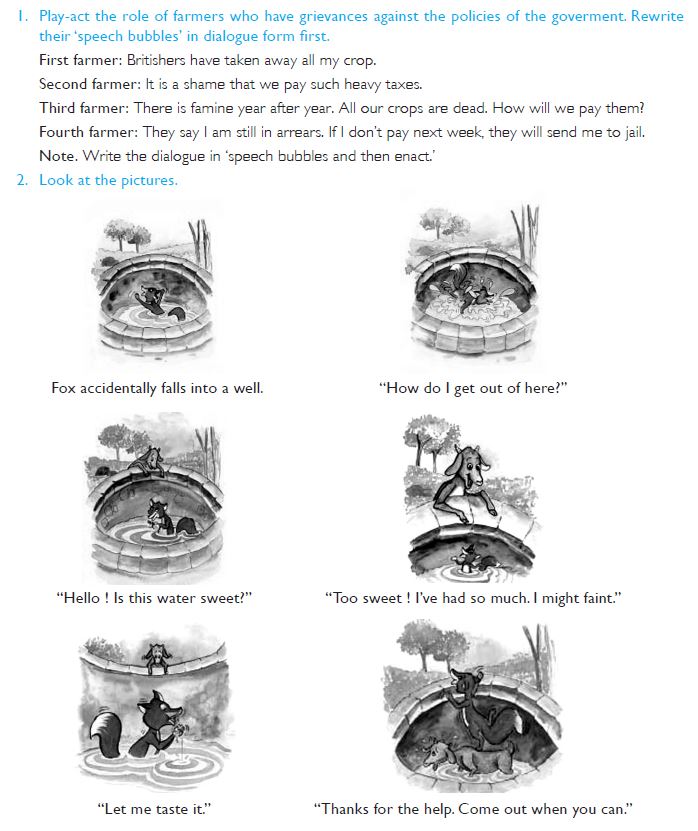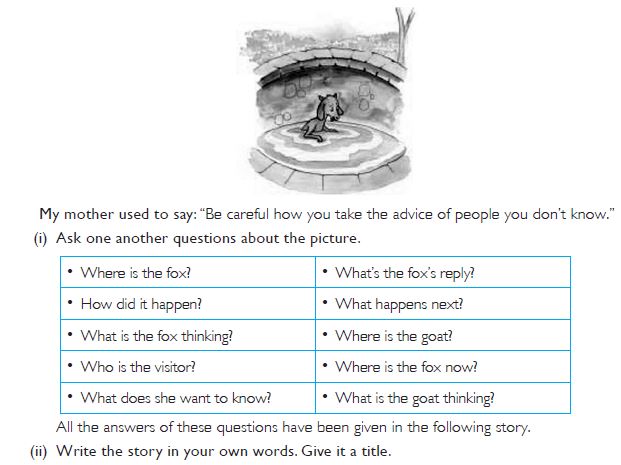Question 1:
Do you think the Indian princes were short-sighted in their approach to the events of 1757?
Answer:
Yes, the Indian princes were short-sighted in their approach to the events of 1757. They fought among themselves. They failed to understand that they were becoming weaker.
Question 2:
How did the East India Company subdue the Indian princes?
Answer:
The rivalries among the Indian princes helped the East India Company to subdue them easily. Indian princes fought with one another. The people had no peace due to their constant fights. The British took advantage of the situation and subdued the Indian princes one by one.
Question 3:
Quote words used by Raja Ram Mohan Roy to say that every religion teaches the same principles.
Answer:
“Cows are of different colours. But the colour of their milk is the same. Different teachers have different opinions but the essence of every religion is the same.”
Question 4:
In what way did the British officers exploit Indians?
Answer:
The British officers drew huge salaries. They also made fortune in private businesses. This ruined the Indian traders.
Question 5:
Name these people.
The ruler who fought pitched battle against the British and died fighting.
Answer:
Tipu Sultan
Question 6:
Name these people.
The person who wanted to reform the society.
Answer:
Raja Ram Mohan Roy
Question 7:
Name these people.
The person who recommended the introduction of English education in India.
Answer:
Macaulay
Question 8:
Name these people.
Two popular leaders who led the revolt. (Choices may vary.)
Answer:
(a) Bahadur Shah Zafar
(b) Nana Sahib
Question 9:
Name these people.
Two examples of social practices prevailing then.
Answer:
(a) Untouchability
(b) Child marriage
Question 10:
Mention the following.
Two oppressive policies of the British.
Answer:
(a) According to Regulation III of 1818, an Indian could be jailed without a trial in a court.
(b) The goods manufactured in England did not have any import duty while Indian goods were heavily taxed.
Question 11:
Mention the following.
Two ways in which common people suffered.
Answer:
(a) British wanted quick profits, so they imposed heavy taxes on the farmers.
(b) Due to the wrong policies of the company, famines between 1822 and 1836 took fifteen lakh lives.
Question 12:
Mention the following.
Four reasons for the discontent that led to the 1857 War of Independence.
Answer:
(a) White soldiers drew big salaries while Indian soldiers got a pittance.
(b) British introduced the use of greased cartridges made from the fat of cows and pigs which was considered sacrilegious by both Hindus and Muslims.
(c) Many landlords had lost their lands because of the British policies. They were discontented.
(d) British policies had ruined expert artisans and their business.
Question 13:


Answer:
The Fox and the Goat
A fox went to a well to drink water. Accidently, he fell into it. He tried to get out but was not successful. In the meantime a goat came there. She saw the fox inside the well. She asked him how all that had happened. The fox was very cunning. He told the goat that he was enjoying the water. The goat asked him if the water was sweet. The fox very smartly replied that it was the sweetest water he had ever tasted. The goat said, “Let me taste it too.” He asked her to bend down. When the goat bent down, the fox hung on to the goat and came out of the water and the goat fell in. He went away saying, “Now enjoy the sweet water.” The story teaches us that we should be aware of cunning people.
Question 14:
Read the following news item.
History becomes fun at this school
Mumbai: Students in the sixth grade of a certain school in Navi Mumbai love their history lessons thanks to a novel teaching aid. It is not surprising given the fact that their study material includes comic books and they use their textbooks for reference to put things into perspective. Besides, students are encouraged to tap other sources of information as well. During history classes, students pore over comic strips of historical periods, enact characters of emperors and tyrants, and have animated discussions on the subject. History has become fun.
In the class students are asked to read the comic strip aloud, after which they break up into groups of four, discuss what they have heard and write a summary. Each group leader reads his group’s summary aloud and the whole class jumps into discussion and debate, adding points, disagreeing and qualifying points of view. A sixth grade student says, “It’s lot of fun because everyone gets a chance to express themselves and the summary takes everyone’s ideas into account.”
According to the school principal, the comic strip format and visuals appeal to students. A historian feels that using comics in schools is a great idea. Comics and acting help students understand what characters in the story are actually thinking. (adapted from The Times of India, New Delhi, October 2007)
Based on this news item, write a paragraph on what you think about this new method of teaching history.
Answer:
This method of teaching history is really very interesting and appealing. Students enjoy reading comics. So they understand the facts easily. Visuals make a permanent print on their minds. Besides, play-acting helps them to know the nature and thoughts of the historical personalities.
Question 15:
Create a comic of your own using this story.
Answer:
Once the Sun and the Wind began to quarrel, each one saying that he was stronger than the other. At last they decided to test each other’s strength. A man with a cloak around his shoulders was passing by. The Wind boasted, “Using my strength I can make that man take off the cloak. The Sun agreed. The Wind blew hard. The man felt so cold that he clasped his cloak round his body as tightly as possible.
Now it was the turn of the Sun which shone very hot indeed. The man felt so hot that he at once removed the cloak from his body. Seeing the man taking off the cloak," the Wind conceded defeat.
Note: Do it with the help of your teacher.
Question 16:
In comics what the characters speak is put in bubbles. This is direct narration. When we report what
the characters speak, we use the method of indirect narration.
Study these examples.
First farmer: Why are your men taking away the entire crop?
Second farmer: Your men have taken away everything.
Officer: You are still in arrears. If you don’t pay tax next week, I’ll send you to jail.
The first farmer asked the officer why his men were taking away the entire crop.
The second farmer said that his men had taken away everything.
The officer replied that they were still in arrears and warned them that if they did not pay tax the following week he (the officer) would send them (the farmers) to jail.
Change the following sentences into indirect speech.
First man: We must educate our brothers.
Second man: And try to improve their material conditions.
Third man: For that we must convey our grievances to the British Parliament.
The first man said that _______________________________________________
The second man added that __________________________________________
The third man suggested that _________________________________________
First soldier: the white soldier gets huge pay, mansions and servants.
Second soldier: we get a pittance and slow promotions.
Third soldier: who are the British to abolish our customs?
The first soldier said that ______________________________________________
The second soldier remarked that _______________________________________
The third soldier asked ________________________________________________
Answer:
they must educate their brothers.
they must try to improve their material condition.
for that they must convey their grievances to the British Parliament.
the white soldiers got huge pay, mansions and servants.
they got a pittance and slow promotions.
who the British were to abolish their customs.
